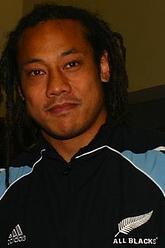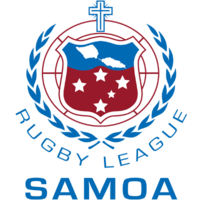
The Samoa national rugby league team represents Samoa in rugby league football and has participated in international competition since 1986. Known as Western Samoa before 1997, the team is administered by Rugby League Samoa and are nicknamed Toa Samoa.

Massey High School is a co-educational state secondary school in West Auckland, New Zealand established in 1969. The school is located on the western edge of the city, thus obtaining students from both suburban and rural backgrounds. In 2017 it was rated decile 4.
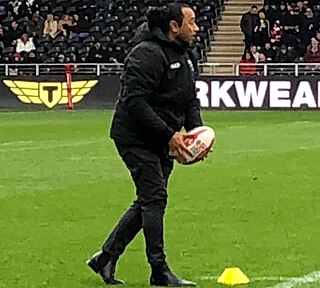
Nigel Faletoese Vagana, also known by the nicknames of "Pablo", and "Chiko", is a former professional rugby league footballer who played in the 1990s and 2000s, as a wing, centre and five-eighth. A New Zealand and Samoa international representative, he retired as the Kiwis' all-time top try-scorer with 19. Vagana played club football in New Zealand for the Warriors, in England for Warrington, and in Australia for the Canterbury-Bankstown Bulldogs, Cronulla-Sutherland Sharks and the South Sydney Rabbitohs. Vagana represented the New Zealand national team 32 times between 1998 and 2006, including playing in the 2000 World Cup. He is also the cousin of Bradford Bulls prop-forward Joe Vagana, and former Silver Ferns netball player Linda Vagana.
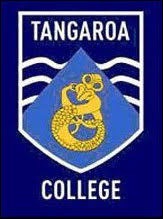
Tangaroa College is a state coeducational secondary school catering for years 9–13 in Ōtara, Auckland, New Zealand.

Mount Albert Grammar School, commonly known as MAGS, is a co-educational state secondary school in Mount Albert in Auckland, New Zealand. It teaches students in year levels 9 to 13. As of August 2021, Mount Albert Grammar School is the second largest school in New Zealand, behind Rangitoto College.
The following lists events that happened during 1996 in New Zealand.
Sheryl Scanlan, originally known as Sheryl Clarke, is a former netball international who has played for Samoa and New Zealand. She captained Samoa at the 1999 World Netball Championships. She was subsequently a member of the New Zealand teams that were gold medallists at the 2003 World Netball Championships and silver medallists at the 2002 Commonwealth Games and 2007 World Netball Championships. During the Coca-Cola Cup/National Bank Cup era, she played for Northern Force. During the ANZ Championship era, she played for Northern Mystics and Southern Steel. In 2022, she was included on a list of the 25 best players to feature in netball leagues in New Zealand since 1998.
De La Salle College is an integrated Catholic secondary boys' school in the south of Auckland, New Zealand. Established in 1953 by the De La Salle Brothers, it continues to educate young men in the Catholic faith and Christian values. In New Zealand there are two schools along with De La Salle College established by the Brothers in New Zealand. Francis Douglas Memorial College in New Plymouth and John Paul College in Rotorua. Students are encouraged to develop every aspect of their person and a strong emphasis is placed on excellence in academic study, cultural pride and sporting ability. Applicants need to be willing to support the Catholic character of the college.
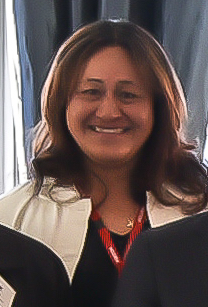
Linda Tuumuliga Vagana is an international netball coach and former representative player from New Zealand. Vagana played as a circle defender, and was a member of the New Zealand national netball team, the Silver Ferns, from 1993 up until 2002, earning 61 caps. She was appointed a Member of the New Zealand Order of Merit in the 2003 Queen's Birthday Honours, for services to netball. Domestically, she played for the Northern Force in the National Bank Cup from 1998 to 2005.

St Paul's College is a Catholic secondary school for boys owned by the Marist Brothers and located in the central Auckland suburb of Ponsonby on a spacious 7.3 hectare campus. The Marist Brothers first opened a school on the site in 1903. St Paul's College commenced operations in 1955..
The New Zealand rugby league season 1997 was the 90th season of rugby league that had been played in New Zealand. The main feature of the year was the Super League Challenge Cup that was run by the New Zealand Rugby League. Waikato won the Challenge Cup by defeating Canterbury 34-18 and also ended the season holding the Rugby League Cup.
The 1993 New Zealand rugby league season was the 86th season of rugby league that had been played in New Zealand. The main feature of the year was the National Provincial Championship competition that was run by the New Zealand Rugby League. Canterbury won the Championship by defeating Auckland 36–12 in the Final.
The 1987 New Zealand rugby league season was the 80th season of rugby league that had been played in New Zealand. The main feature of the year was the Interdistricts Series competition that was run by the New Zealand Rugby League. Auckland won the series, defeating the other three inter-district teams.
The 1991 New Zealand rugby league season was the 84th season of rugby league that had been played in New Zealand. The main feature of the year was the National Provincial Competition that was won by Auckland.
The 2014 New Zealand rugby league season was the 107th season of rugby league that had been played in New Zealand. The main feature of the year was the National Competition run by the New Zealand Rugby League. The Albert Baskerville Trophy was won by the Canterbury Bulls.
The Samoa women's national rugby league team, also known as the Fetū Sāmoa, represents Samoa in Women's rugby league. They are administered by the Rugby League Samoa.
South African New Zealanders are New Zealanders who were either born in South Africa or are descendants of South African migrants. As of the 2018 New Zealand census, there were 71,382 South African-born people resident in New Zealand, or 1.52% of the country's population, making South Africa the 5th largest source of immigrants in New Zealand behind the United Kingdom, China, India, and Australia. While South Africans have migrated to New Zealand since the 19th century, over 90 percent of South Africans in New Zealand today have migrated since the fall of apartheid in the early 1990s. Most South African New Zealanders are of White South African origin.
Cynthia Ta'ala is a sportswoman who has played rugby league for the New Zealand women's national rugby league team and has captained the Samoa women's national rugby union team, of which she is now its assistant coach. She has also played for the New Zealand women's national basketball team.
Elisapeta Toeava is a netball player who was born in Samoa and moved to New Zealand. A player for the Northern Mystics team in Auckland, as of the end of 2021 she had also played three matches for the New Zealand national netball team.


